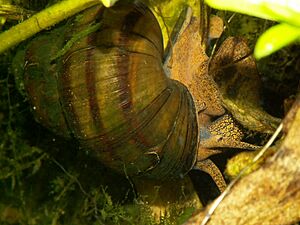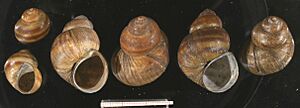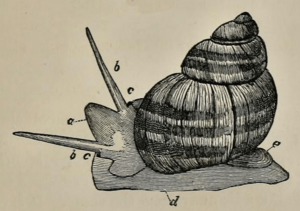Viviparus viviparus facts for kids
Quick facts for kids Viviparus viviparus |
|
|---|---|
 |
|
| A live individual of Viviparus viviparus | |
 |
|
| Six shells of Viviparus viviparus, including two juveniles | |
| Conservation status | |
| Scientific classification | |
| Synonyms | |
|
The Viviparus viviparus is a type of large freshwater snail. It has a gill to breathe underwater and a special lid called an operculum. This snail is an aquatic gastropod mollusk from the family Viviparidae, also known as river snails. What makes this snail special is that it is viviparous, meaning it gives birth to live young instead of laying eggs.
Contents
About the River Snail
The shell of this snail is usually about 25 to 35 millimeters (about 1 to 1.4 inches) tall. It is 20 to 26 millimeters (about 0.8 to 1 inch) wide. Male snails are a little smaller than females of the same age.
The shell is often dark greenish-brown or yellowish-grey. It usually has three reddish-brown spiral bands. The shell has lines on it but no special hammer-like pattern. The very top of the shell is blunt, not pointy like some other Viviparus species.
The shell has about 5.5 to 6 slightly rounded sections called whorls. The last whorl is quite big compared to other snails in its family. The opening at the center of the shell, called the umbilicus, is narrow.
This snail can close itself off with a round lid called an operculum. This lid has circular lines on it. It helps the snail protect itself from drying out. It can even stay closed for several months if needed. When the snail closes its operculum, it fits perfectly with the shell's opening.
The operculum is attached to the back of the snail's foot. The snail's body is wide and T-shaped. Its color can be spotted grey, greenish, or orange.
The snail has a mouth with a radula, which is like a tiny, toothed tongue. It uses this to scrape food. It also has a breathing tube called a respiratory siphon on the right side of its head. This siphon helps water flow over its gills, which are located near its heart. This also helps the snail filter water for food. The snail has two short tentacles with eyes on the outside of each one.
Where They Live
This snail is found in many parts of Europe. You can find it in countries like Romania, Slovenia, Croatia, the Czech Republic, Germany, the Netherlands, Poland, Great Britain, and Ireland.
Viviparus viviparus mostly lives in large, slow-moving rivers and lakes in low-lying areas. They prefer water that has a lot of calcium. These snails often live in deep water.
Sometimes, you can find thousands of these snails grouped together. They might be on submerged tree branches or on objects humans have placed underwater. Less often, they are spread out in the mud at the bottom, where they are harder to spot. They can also be found in canals, man-made ponds, and reservoirs behind dams. However, they usually do not live in small, isolated puddles or ponds. They need water with a lot of oxygen to survive.
What They Eat
Viviparus viviparus snails eat tiny living things called plankton. They also eat small pieces of dead plants and animals floating in the water. They use their siphon to suck in water. This allows them to breathe and filter food at the same time.
Because they filter the water, these snails are popular with people who have ponds or aquariums. They are known to eat stringy algae, tiny algae, and other waste. This helps to clean and clear the water. However, these snails can sometimes carry certain parasites.
Reproduction and Life Cycle
As its Latin name suggests, this snail is viviparous. This means the female gives birth to live young. This is quite rare for snails, as most lay eggs. The eggs actually hatch inside the mother's body.
A naturalist named Jan Swammerdam was the first to realize that this snail gives birth to live young. Later, in 1863, Émile Baudelot clearly stated that these river snails have separate male and female sexes. This was important because most other snails are hermaphrodites, meaning they have both male and female parts.
These snails become adults after about two years, when they are about 2 centimeters (0.8 inches) long. Each female can carry up to 30 eggs inside her. These eggs can be at different stages of development, from 3 to 7 millimeters (0.1 to 0.3 inches) wide. When the young snails are born, they are about 7 millimeters long. Their shells already have the stripes typical of river snails. After a female snail gives birth to all her young, she dies.
Who Eats Them?
The main animals that eat Viviparus viviparus are fish and certain insects. These insects include beetles (Coleoptera) and true bugs (Hemiptera).
Viviparus viviparus can also be a host for some types of trematodes. These are tiny worms that complete their life cycle in other animals like mammals and birds.



